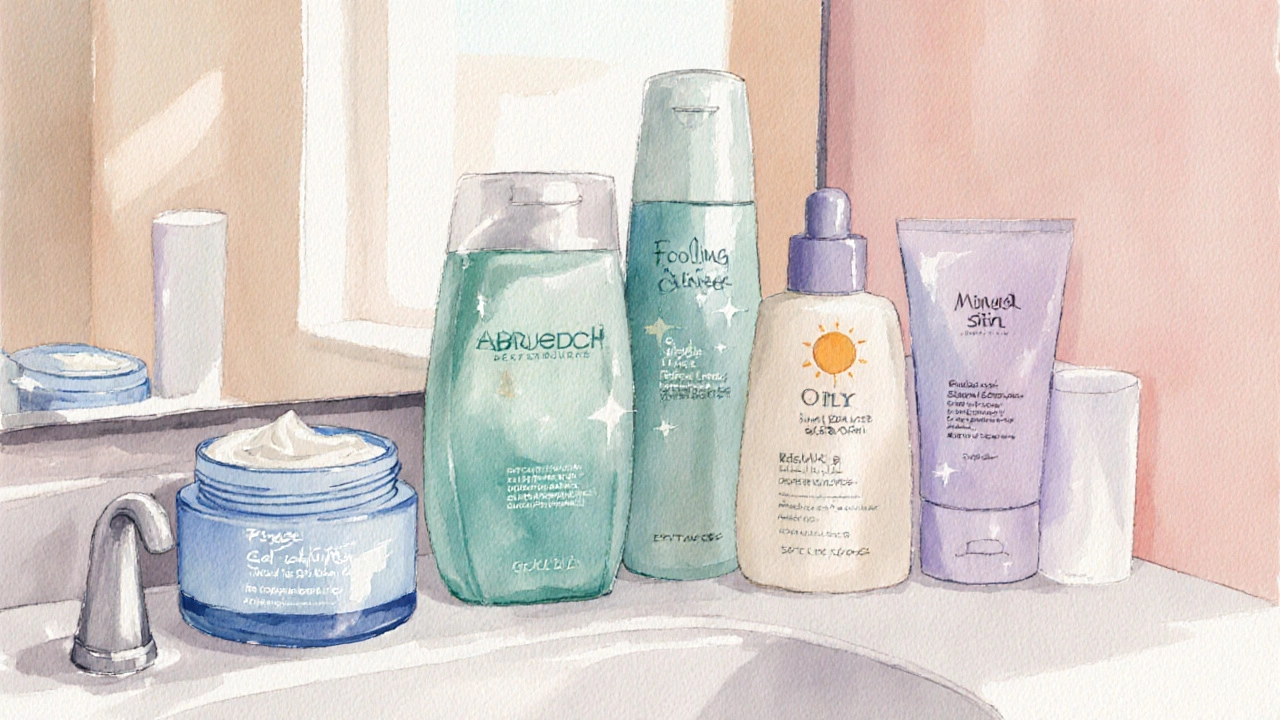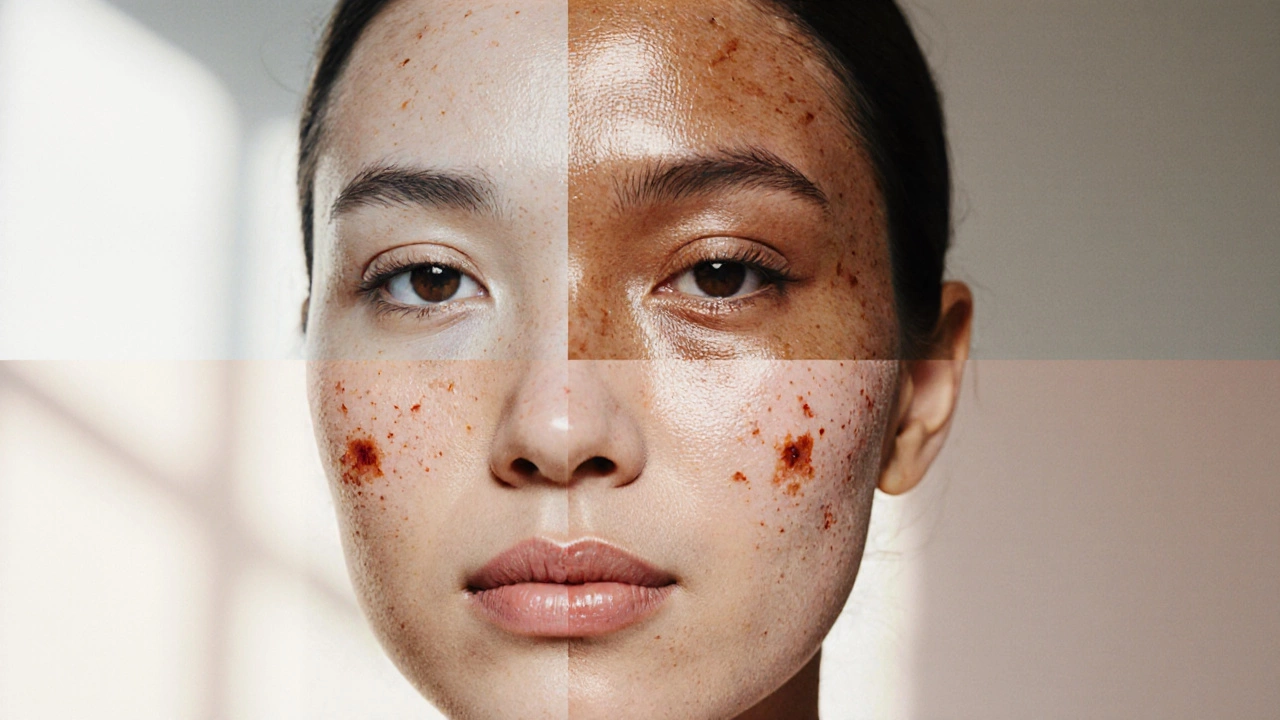Skin Type Identifier Quiz
Answer a few questions to identify your skin type and get personalized recommendations.
Your Skin Type
Ever wonder why the same product works wonders for one friend but leaves your face feeling greasy or tight? The answer usually lies in your skin’s classification. Knowing the four main Skincare Types is the first step toward a routine that actually respects your skin’s needs.
What Are the 4 Skincare Types?
Dermatologists typically split skin into four buckets based on oil production, moisture levels, and sensitivity. Each type reacts differently to products, climate, and even diet.
- Dry Skin: Feels tight, may show flaking, and often looks dull. It produces less sebum, so the barrier can become compromised.
- Oily Skin: Shiny, especially in the T‑zone, with larger pores and a tendency toward breakouts. Excess sebum can trap dirt and bacteria.
- Combination Skin: A hybrid of dry and oily zones-usually oily in the forehead, nose, and chin, while cheeks stay dry or normal.
- Sensitive Skin: Reacts easily to fragrances, alcohol, or harsh ingredients, often showing redness, itching, or a burning sensation.
How to Identify Your Skin Type
Pinpointing your type doesn’t require a lab test-just a few simple observations.
- Wash your face with a gentle cleanser and pat dry. Wait about an hour without applying any products.
- Examine the feel of your skin. Tightness indicates dryness; a glossy sheen signals oiliness.
- Look for patterns. If only the T‑zone feels greasy while the cheeks stay matte, you’re likely combination.
- Notice any reactions. Redness or stinging after a routine suggests sensitivity.
To double‑check, you can press a blotting paper against different areas. The amount of oil transferred will confirm your assessment.

Tailoring Your Routine to Each Type
Once you know your classification, you can match every step-cleanser, moisturizer, sunscreen, and occasional exfoliation-to what your skin truly needs.
Dry Skin
- Cleanser: Cream‑based, sulfate‑free formulas that add moisture while cleansing.
- Moisturizer: Look for hyaluronic acid, glycerin, and ceramides. Apply while skin is still damp to lock in water.
- Sunscreen: Mineral options with zinc oxide provide protection without drying out.
- Exfoliation: Limit to once a week with a mild enzyme mask; harsh scrubs can worsen barrier loss.
Oily Skin
- Cleanser: Gel‑based or foaming cleansers with salicylic acid to dissolve excess sebum.
- Moisturizer: Lightweight, oil‑free gels that contain niacinamide to regulate oil production.
- Sunscreen: Broad‑spectrum, matte‑finish formulas that don’t leave a greasy residue.
- Exfoliation: Chemical exfoliants (AHA/BHA) two to three times a week keep pores clear.
Combination Skin
- Cleanser: Balanced, pH‑neutral foaming cleansers that clean without stripping.
- Moisturizer: Use a lightweight lotion on oily zones and a richer cream on drier cheeks, or opt for a hybrid moisturizer with a balanced oil‑water ratio.
- Sunscreen: Choose a broad‑spectrum SPF 30‑50 that feels breathable.
- Exfoliation: Alternate between gentle AHAs for dry spots and BHA pads for the T‑zone.
Sensitive Skin
- Cleanser: Fragrance‑free, hypoallergenic milks or micellar water.
- Moisturizer: Products with soothing ingredients like oat extract, aloe, and centella asiatica.
- Sunscreen: Mineral sunscreens with zinc oxide or titanium dioxide, free from chemical filters.
- Exfoliation: Stick to once‑a‑week, low‑pH enzyme masks; avoid acids unless patch‑tested.
Common Mistakes and How to Avoid Them
- Using the same product for every skin type. Tailor ingredients; a heavy cream meant for dry skin will clog pores on oily skin.
- Skipping sunscreen. UV damage affects all types, accelerating dryness, oiliness, and sensitivity.
- Over‑exfoliating. More isn’t better; it strips the protective barrier and invites irritation.
- Ignoring pH balance. Products with a pH far from the skin’s natural 4.5‑5.5 can disrupt the microbiome.
- Neglecting lifestyle factors. Diet, sleep, and stress impact oil production and inflammation.

Comparison of the 4 Skincare Types
| Attribute | Dry | Oily | Combination | Sensitive |
|---|---|---|---|---|
| Typical Oil Level | Low | High | Variable (high T‑zone, low cheeks) | Low to moderate, reacts easily |
| Common Issues | Flaking, tightness | Acne, shine | Mixed breakouts, dry patches | Redness, stinging |
| Best Cleanser Type | Cream‑based, sulfate‑free | Gel/foaming with salicylic acid | pH‑neutral foaming | Hypoallergenic milky |
| Ideal Moisturizer | Rich, ceramide‑heavy | Oil‑free gel | Hybrid or zone‑specific | Soothing oat/aloe |
| Sunscreen Preference | Mineral, non‑drying | Matte‑finish, broad‑spectrum | Breathable SPF 30‑50 | Mineral, fragrance‑free |
| Exfoliation Frequency | 1 × week, enzyme | 2‑3 × week, AHA/BHA | Alternating zones, 2 × week | 1 × week, low‑pH enzyme |
Frequently Asked Questions
How often should I change my skincare routine?
Seasonal shifts, hormonal changes, or skin reactions are good cues. Most experts suggest a light review every three months, or sooner if you notice new breakouts or dryness.
Can I have more than one skin type on my face?
Absolutely. The combination type is the most common, where you’ll see oily T‑zone and drier cheeks. Even dry‑skinned people can develop occasional oily patches around the nose.
Is it safe to use the same sunscreen year‑round?
Yes, as long as it offers broad‑spectrum protection and suits your skin’s texture. For oily skin, a matte‑finish mineral sunscreen works all year; for dry skin, a moisturizing SPF cream is ideal.
Do diet and water intake affect my skin type?
Hydration helps maintain barrier function, and a diet rich in omega‑3 fatty acids can calm oil production. While diet won’t flip a dry face to oily, it can ease extreme symptoms.
How do I know if a product is too harsh for my skin?
Watch for immediate stinging, redness that lasts more than a few minutes, or a persistent tight feeling after use. Conduct a 48‑hour patch test on the jawline before applying a new product to the whole face.





